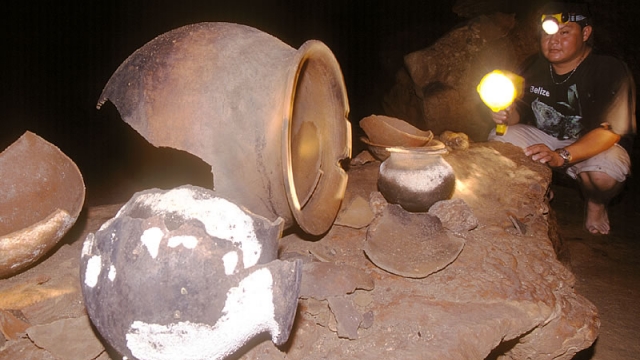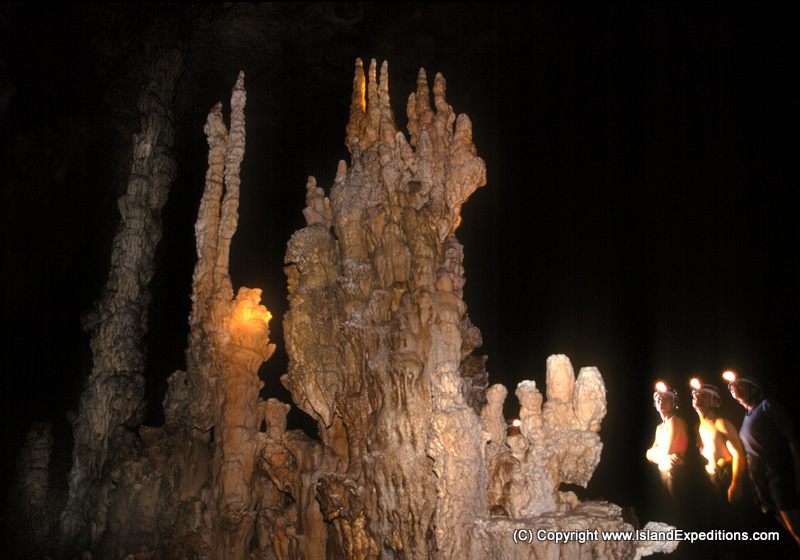
Here is an interesting article on ATM Caves which appeared recently in the Chicago Tribune. Actun Tunichil Muknal, known locally as “Xibalba” or ATM, is one of the most popular Mayan burial sites in Western Belize. The renowned cave contains four skeletons, ceramics, and stoneware left by the Maya. We include a visit to ATM on our Ultimate Adventure trip.
Exploratory travel isn't about creature comforts
ATM cave in Belize brings unlikely adventure while swimming in a dark cave to Mayan ruins
December 05, 2013|Josh Noel | Tribune Travels
I've been to the top of Mount Kilimanjaro and the bottom of the Grand Canyon, but one of the most stunning adventures I've had fits squarely between those extremes.
On a recent trip to Belize, I spent a day at the Actun Tunichil Muknal cave in the western part of the country, not far from the Guatemalan border. The journey begins innocently enough at a parking lot at the end of a heavily divoted dirt road ("free massage," as Belizean tour guides say).
My group of four — our Belizean guide, Ben; a woman from Atlanta; and my travel companion and I — divided lunch, water, headlamps and helmets across our backpacks and headed out on what momentarily seemed like any other jungle hike. It quickly was not like any other jungle hike.
Within 100 yards, we reached our first river crossing. Ben, who is one of about 20 guides certified to lead ATM expeditions, jumped in and started walking. We followed.
The current was strong after weeks of rain, and as the water rose to our chests, each step was a battle to stay upright against both the current and the barely visible bed of rocks on the river floor. We emerged drenched but fine on the other side: The water was warm, and the jungle air even warmer.
Water sloshed from our hiking boots as we walked on to another river crossing and then another. In more developed countries, bridges would have kept us above the river. Not in western Belize, and that was fine, considering the adventure ahead.
After about a mile and a half, we arrived at a picnic area. Ben instructed us to drop our backpacks and grab sips of water. Meanwhile, he affixed headlamps to our helmets. We left our packs behind as we walked from the clearing to a pool of blue-green water leading to the mouth of a tall cave that led into darkness.
Ben instructed us to keep our heads above water — the headlamps wouldn't appreciate being submerged, and wet helmets would be no fun — and he jumped feet first into the water. In full hiking gear — shorts, T-shirts, boots — we followed.
Swimming in clothes and hiking boots fights common sense and feels counterintuitive, as all that weight counters an improvised combination of the breast stroke and dog paddle into a darkened cave. Drenched, we reached a thin sliver of rock, where we paused as a final shaft of light glowed in the direction where we had begun. Ben let us catch our breath as he explained that the rock before us was dead coral once at the bottom of the ocean.
In truth, I didn't hear a word he said; I was too excited by swimming into a cave and trying to conceive of what lay ahead. Ben told me later that no one hears what he says at that moment, and the reason he stops there is because if someone is going to become overwhelmed — by the dark, the narrow space, the unknown, the swimming into the earth in full clothes — this is where it happens.
On we went, trudging through water that was at times ankle deep and at other times deep enough to demand further swimming, boots churning through the water and worlds lit by the lamps on our heads. It was an odd sensation but not uncomfortable; the water temperature was in the mid-70s, and the air a bit warmer. When the water was shallow enough, we would pause for Ben to show us the impossible shapes hidden in the dark: fantastic, rippling stalactites and massive chunks of dead coral.
After about an hour we reached a point in the cave where Ben said we would stop going forward; we would be going up. We climbed a rock to a landing that Ben said Mayans are believed to have used for ceremonial purposes around the years 300 to 900. At our feet were pieces of pottery and, as we went on, a skull and pieces of bone.
Arriving at the Crystal Maiden, about 21/2 hours after we began, is considered the pinnacle of the adventure. It is indeed a stunning sight: the remains of a sacrificed teenage girl whose skeleton has been kept largely intact by a layer of shimmering limestone.
But what made ATM so memorable wasn't the end; it was the journey. You get wet, and you deal with it. You hike with wet clothes and shoes, and you deal with it. You climb across wet rocks in darkness, beholden to the goodwill of your headlamp, and you deal with it. And for those who don't want to deal with such inconveniences, hear this: The ATM cave is not for you.
But for those after an adventure, the journey felt like an exhilarating gamble. It was the kind of adventure that is challenging, educating, stimulating and humbling. And that, of course, is why we travel.
jbnoel@tribune.com
